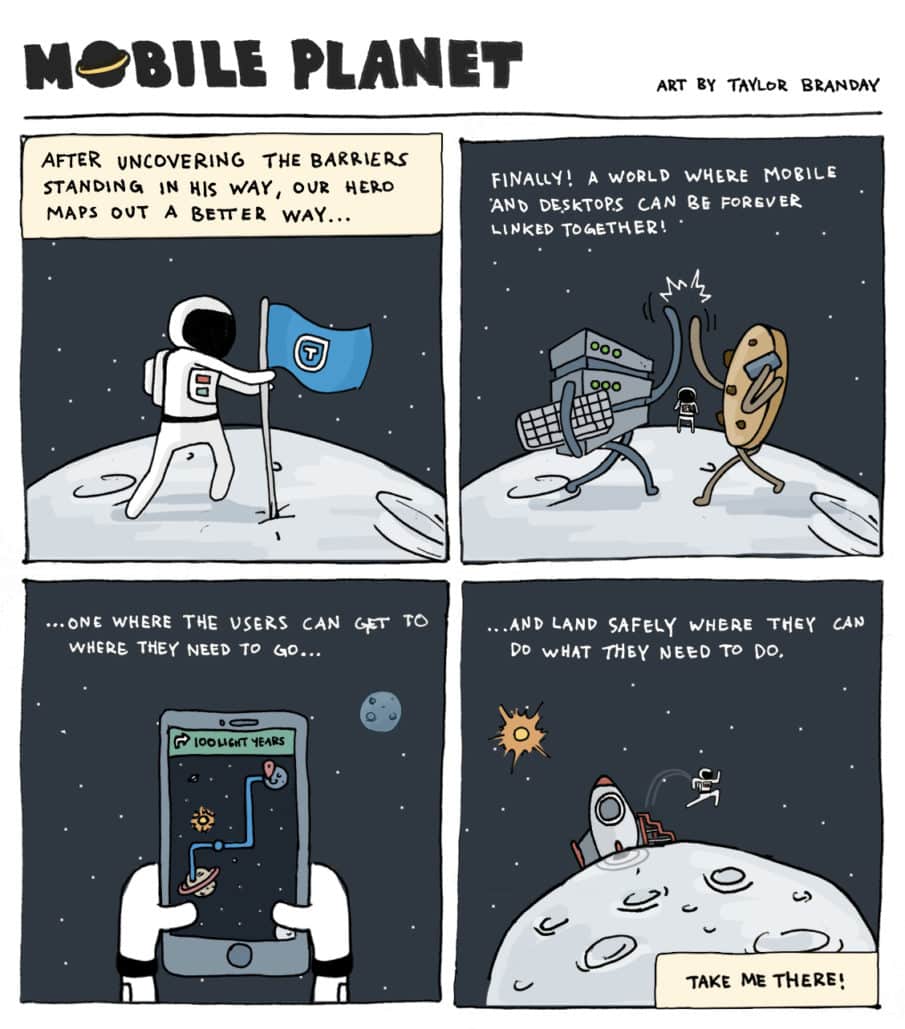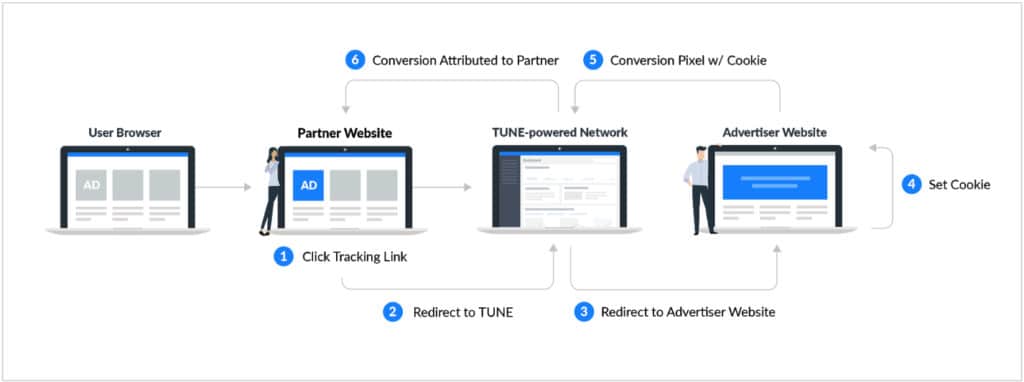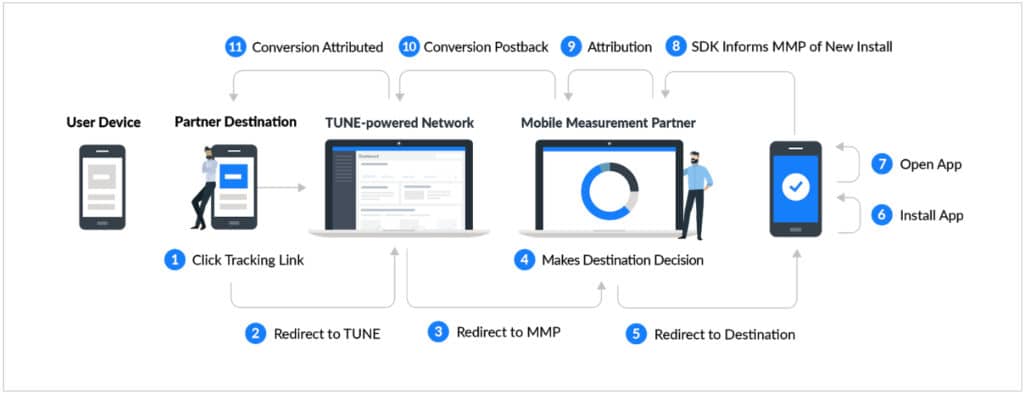
Welcome to our third installment of Mobile Planet, our short series on the technology and partnerships that power mobile partner marketing. If you are just “tuning in,” let’s get you caught up. Last we left off, our hero was exploring an ever-changing, ever-expanding marketingverse that was tilting mobile. Despite mobile’s gravitational force, two partner marketing factions — one born on mobile, and one born on desktop — were stuck in a standoff, unable to navigate around some barriers.
Spoiler alert: in today’s episode, we will discover that these barriers are actually quite solvable. And like most amazing discoveries, the solution has been there all along, hiding in plain sight.
One Important Step for Partner Technology, One Giant Step for Partnerkind
In the real world, if you are a brand working with a mobile app, chances are someone in your organization may just be your own internal hero. Bridging the gap between your mobile and desktop partnerships should not be a giant technological step for you; but, it should be a giant leap for your partner program and your ability to scale. So, if you could turn your mobile partners into performance-based partnerships (beyond the install), why wouldn’t you do it?
Let me be more direct:
- You need to do this!
- You can do this!
- You can succeed at this because the stuff you’re used to (cookies and pixels) have mobile analogues that are easy to use, and you can start using them today.
But, even more pressing, how would you do it? First, it’s best to level set on what the historical flow of a desktop transaction looks like. This is the world of cookies:

- Step 1: A user clicks on an ad discovered on a partner’s (or affiliate or publisher’s) website.
- Step 2: The user is seamlessly redirected through the partner’s network. In this case, let’s assume it’s a TUNE-powered network. The click (and associated data) is recorded.
- Step 3: The network, in turn, seamlessly redirects the user to the advertiser’s website or landing page.
- Step 4: On the landing page, a cookie is dropped on the browser.
- Step 5: An event (e.g., a purchase or sign-up) occurs and is recorded in the cookie, and a conversion pixel is fired back to the network to connect the original click to the conversion.
- Step 6: In this case, assuming that is the only touchpoint, this event is attributed to the partner and the partner is notified.
Now, let’s play it out in the mobile world, so we can begin to see the parallels.
Tracking
First things first: cookies simply do not work well in mobile. Cookies do not work at all for mobile apps, and with Apple’s new Intelligent Tracking Prevention 2.2 release, they’re unreliable for mobile web tracking. Good news, this is not a big problem, as mobile environments have long prepared for this change. In order for tracking to work within mobile, both apps and mobile websites use technology called software development kits (SDKs) and communicate click and tracking events through server-to-server communications called “postbacks.” These SDKs replicate some of the behavior found in the desktop cookie world.

Mobile Advertiser IDs and Routing
App and mobile web SDKs enable accurate, affiliate-grade attribution by allowing the following:
- If the user is directed to an app already installed on their device, the app SDK can see the inbound click and all the data associated with it. It can then connect every event that happens in the app right back to the click — allowing for perfect attribution.
- If the user is directed to a mobile website on their device, the mobile web SDK can track the information on the inbound click, track it via cookieless local storage, and use this information to track future events on that mobile website back to the click.
- If the user is directed to a mobile app that is not installed on their device, the app SDK can see the install once the user has gone through the app install process, determine what part of the app the user meant to go to when they clicked the ad, and automatically redirect them to the right location. It can also determine what user clicked the ad, store this information, and connect every subsequent event that happens in the app right back to the click — allowing for perfect attribution.
How is this done? Via advertising identifiers and deferred deep linking. All iOS and Google Play-enabled Android devices have unique advertiser IDs provided by Android and iOS that are attached to a user’s mobile device. These IDs are unique to the device and user, and are a means to deterministically connect ad clicks in one mobile app and behavior in another. Because of these IDs, SDKs are able to deterministically match click to conversion — even if there’s a trip to the app store in the middle — which also allows them to put the user in exactly the right spot once they are finished with their install.
Pulling It All Together
Now that you have a better overall feel for how desktop and mobile are tracked, consider this analogy:
Cookies (pixels and browsers) are to the traditional web as SDKs (and advertiser IDs) are to mobile apps.
Let’s take it a step further. Mobile measurement companies such as AppsFlyer, Branch, Adjust, Kochava, and Singular do the stitching and the attribution in the mobile world. They replace desktop cookie and pixel. In some insider circles, this group is known as mobile measurement partners (MMPs). They track mobile app events (install and post-install) through their proprietary SDKs, which sit on top of an advertiser’s app and mobile website, much like the functionality of a cookie and its pixel. And they stitch the events all back to a singular customer identity, including all of the different touchpoints. Some companies can easily do multi-channel as well.
Now that you have a better overall feel for how desktop and mobile traffic are routed, consider this analogy:
Smart linking is to desktop as Universal / deep linking is to mobile.
Since mobile measurement partners do the tracking, they are uniquely positioned to do the routing of the user to the landing page. Much like in the desktop world, where the network redirects users to a landing page via a destination URL, MMPs are able to choose places for users to land depending on the context (e.g., downloading the app, sending the user deep to a landing page within the app, or sending the user to mobile web).
Beam Me Up, Scotty
If your company measures their mobile marketing with any of these mobile partners, you can leverage TUNE’s technology today within your current partner program to go beyond measuring (attributing) partners to managing (optimizing and paying) these partners. Setting up a partner program to bring together your mobile and desktop partners is not only achievable, it is easy.
So, if you remember nothing else from today’s adventure, remember this:
- You need to do this! Seriously! Mobile partners are open for business.
- You can do this! Seriously! Mobile measurement can work, without implementing additional SDKs in TUNE today.
- You can succeed at this because it’s the stuff you’re used to. Cookies and pixels have mobile analogues that make this imminently doable.
Head over to Part 4, the next and last installment of Mobile Planet to discover a solution that can tie this all together right here on planet Earth.
Want to skip the series? Get the whole story in our e-book, “Mobile Planet: A Brave New World for Affiliate Partnerships.”
Author
Becky is the Senior Content Marketing Manager at TUNE. Before TUNE, she handled content strategy and marketing communications at several tech startups in the Bay Area. Becky received her bachelor's degree in English from Wake Forest University. After a decade in San Francisco and Seattle, she has returned home to Charleston, SC, where you can find her strolling through Hampton Park with her pup and enjoying the simple things in life.




Leave a Reply
You must be logged in to post a comment.